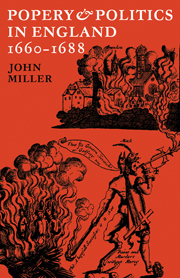Book contents
- Frontmatter
- Contents
- Preface
- Abbreviations
- Note on spellings and dates
- Introduction
- 1 The Catholic laity
- 2 England and Rome: the Catholic clergy
- 3 The penal laws and their enforcement
- 4 The development of the anti-Catholic tradition
- 5 The Restoration settlement and after
- 6 The French alliance and ‘Catholicity’
- 7 York and Danby
- 8 The Popish Plot and the Exclusion Crisis
- 9 The Tory reaction
- 10 James II and the Church of England Men
- 11 James II and the Dissenters
- 12 James II and Rome
- 13 The missionary effort under James II
- 14 The opposition to James II
- Appendices
- Select Bibliography
- Index
4 - The development of the anti-Catholic tradition
Published online by Cambridge University Press: 07 October 2011
- Frontmatter
- Contents
- Preface
- Abbreviations
- Note on spellings and dates
- Introduction
- 1 The Catholic laity
- 2 England and Rome: the Catholic clergy
- 3 The penal laws and their enforcement
- 4 The development of the anti-Catholic tradition
- 5 The Restoration settlement and after
- 6 The French alliance and ‘Catholicity’
- 7 York and Danby
- 8 The Popish Plot and the Exclusion Crisis
- 9 The Tory reaction
- 10 James II and the Church of England Men
- 11 James II and the Dissenters
- 12 James II and Rome
- 13 The missionary effort under James II
- 14 The opposition to James II
- Appendices
- Select Bibliography
- Index
Summary
If the Catholics really were so few and so harmless, how is one to explain the ferocious anti-Catholicism of this period? The answer lies partly in the Protestant view of Catholics and Catholicism, as it had developed over more than a century, and partly in the way that this view of Catholicism affected Protestants' interpretation of current political events. The Protestant version of history since the Reformation showed Papists as obedient slaves to the pope, whose greatest ambition was to root out Protestantism with the maximum of bloodshed and cruelty; this gave a distorted picture even of the Catholics of Elizabeth's reign, since which time circumstances had changed so that it bore only a minimal resemblance to reality. However, the myth of the bloodthirsty Papist seemed to acquire new relevance from two important contemporary developments. The first was the emergence of Louis XIV as the most powerful ruler in Europe and the self-styled champion of Catholicism. However weak the Catholics might seem in England, in Europe as a whole they were very much in the ascendant. In the words of Professor Kenyon: ‘When the Thirty Years' War ended, Protestantism had been driven out to the periphery of Europe, where it was precariously lodged in North Germany, Holland, Scandinavia, England and Scotland; all, with the exception of Holland, poor, thinly populated, second-class nations.’ The emergence in this situation of a new Catholic super-power to offset the decline of Spain made the second new development particularly ominous. From 1673 it was clear that James, duke of York, the king's brother and heir-apparent, had become a Catholic.
- Type
- Chapter
- Information
- Popery and Politics in England 1660–1688 , pp. 67 - 90Publisher: Cambridge University PressPrint publication year: 1973
- 2
- Cited by



